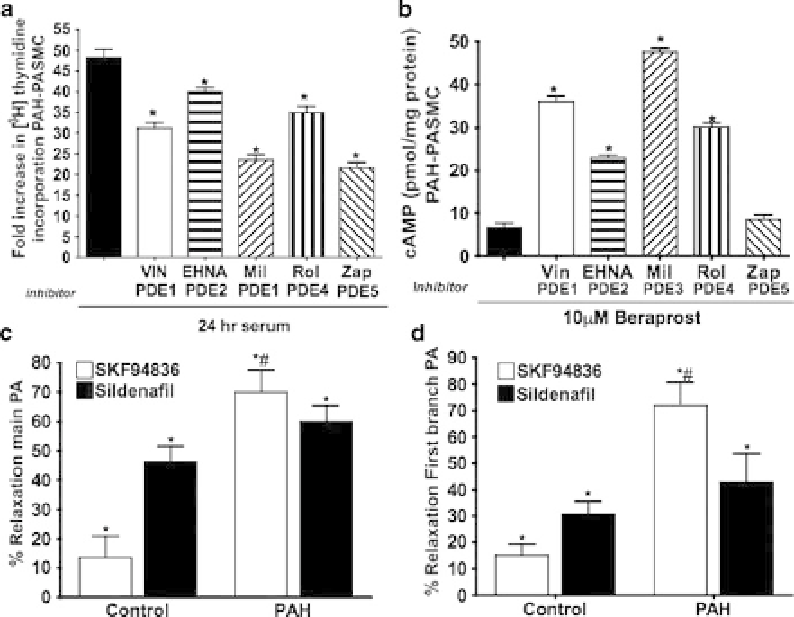Biology Reference
In-Depth Information
Fig. 2 PDE inhibitors decrease proliferation and increase cAMP in PAH-PASMCs and relax PA.
(a) PDE inhibition [PDE1, vinpocetine (Vin); PDE2, erythro-9-(2-hydroxy-3-nonyl)-adenine
(EHNA); PDE3, milrinone (Mil); PDE4, rolipram (Rol) and PDE5, zaprinast (Zap), all 10
m
M]
decreased serum-induced proliferation of PAH-PASMCs. (b) PDE inhibition increased cAMP
accumulation, with the exception of PDE5 inhibition, in response to Beraprost (10
m
M, 10 min).
(c) Main and (d) first branch PA from control and chronic-hypoxic rat were contracted with
phenylephrine (1
m
M) and relaxation was measured after PDE3 (10
m
M, SKF94836) and PDE5
inhibition (10
m
M, Sildenafil). An organ bath preparation with an isometric force transducer was
used to measure vessel tension in isolated PA. The concentration of PE used resulted in a sustained
contraction that was approximately 80-90% of the maximum KCl response.
n
¼
5*
P
<
0.05 vs.
minus PDE inhibitor #
P
0.05 vs. control PA
<
provided to show such benefit in other classes of pulmonary hypertension or that
life expectancy is improved (Ghofrani et al.
2002
; Michelakis et al.
2002
; Wilkens
et al.
2001
). The first large-scale clinical trial to show the beneficial effects of
sildenafil (20, 40, and 80 mg three times a day) for PAH was termed SUPER
(Sildenafil Use for Pulmonary Hypertension, a study in which 30% of the patients
had PAH). SUPER demonstrated that 80 mg sildenafil decreased PVR by 177-365
(mean 261) dyne s cm
5
, decreased PAP by 2.8-6.7 (mean 4.7) mmHg, and
increased the 6-min walking distance by an average of 48 m over 12 weeks, an
effect that was sustained for
1 year (Galie et al.
2005
). Although sildenafil
produced a dose-dependent decrease in PVR in PAH patients, the increase in the
6-min walk test was not, such that the 20 mg dose had an effect similar to that of
both 40 and 80 mg. Explanation for the lack of dose-response of sildenafil may be
>

